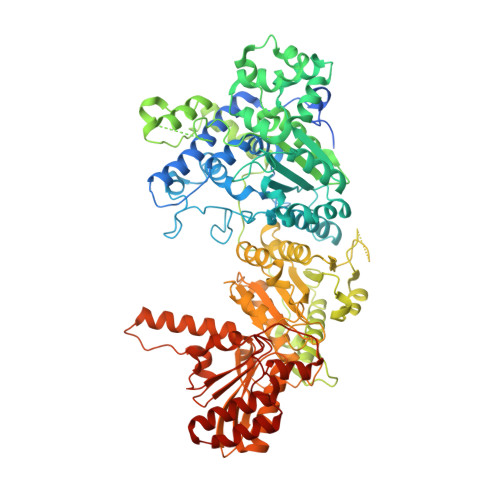A Thiamin-bound, Pre-decarboxylation Reaction Intermediate Analogue in the Pyruvate Dehydrogenase E1 Subunit Induces Large Scale Disorder-to-Order Transformations in the Enzyme and Reveals Novel Structural Features in the Covalently Bound Adduct.
Arjunan, P., Sax, M., Brunskill, A., Chandrasekhar, K., Nemeria, N., Zhang, S., Jordan, F., Furey, W.(2006) J Biol Chem 281: 15296-15303
- PubMed: 16531404
- DOI: https://doi.org/10.1074/jbc.M600656200
- Primary Citation of Related Structures:
2G25, 2G28 - PubMed Abstract:
The crystal structure of the E1 component from the Escherichia coli pyruvate dehydrogenase multienzyme complex (PDHc) has been determined with phosphonolactylthiamin diphosphate (PLThDP) in its active site. PLThDP serves as a structural and electrostatic analogue of the natural intermediate alpha-lactylthiamin diphosphate (LThDP), in which the carboxylate from the natural substrate pyruvate is replaced by a phosphonate group. This represents the first example of an experimentally determined, three-dimensional structure of a thiamin diphosphate (ThDP)-dependent enzyme containing a covalently bound, pre-decarboxylation reaction intermediate analogue and should serve as a model for the corresponding intermediates in other ThDP-dependent decarboxylases. Regarding the PDHc-specific reaction, the presence of PLThDP induces large scale conformational changes in the enzyme. In conjunction with the E1-PLThDP and E1-ThDP structures, analysis of a H407A E1-PLThDP variant structure shows that an interaction between His-407 and PLThDP is essential for stabilization of two loop regions in the active site that are otherwise disordered in the absence of intermediate analogue. This ordering completes formation of the active site and creates a new ordered surface likely involved in interactions with the lipoyl domains of E2s within the PDHc complex. The tetrahedral intermediate analogue is tightly held in the active site through direct hydrogen bonds to residues His-407, Tyr-599, and His-640 and reveals a new, enzyme-induced, strain-related feature that appears to aid in the decarboxylation process. This feature is almost certainly present in all ThDP-dependent decarboxylases; thus its inclusion in our understanding of general thiamin catalysis is important.
Organizational Affiliation:
Biocrystallography Laboratory, Veterans Affairs Medical Center, Pittsburgh, Pennsylvania 15240, USA.
















